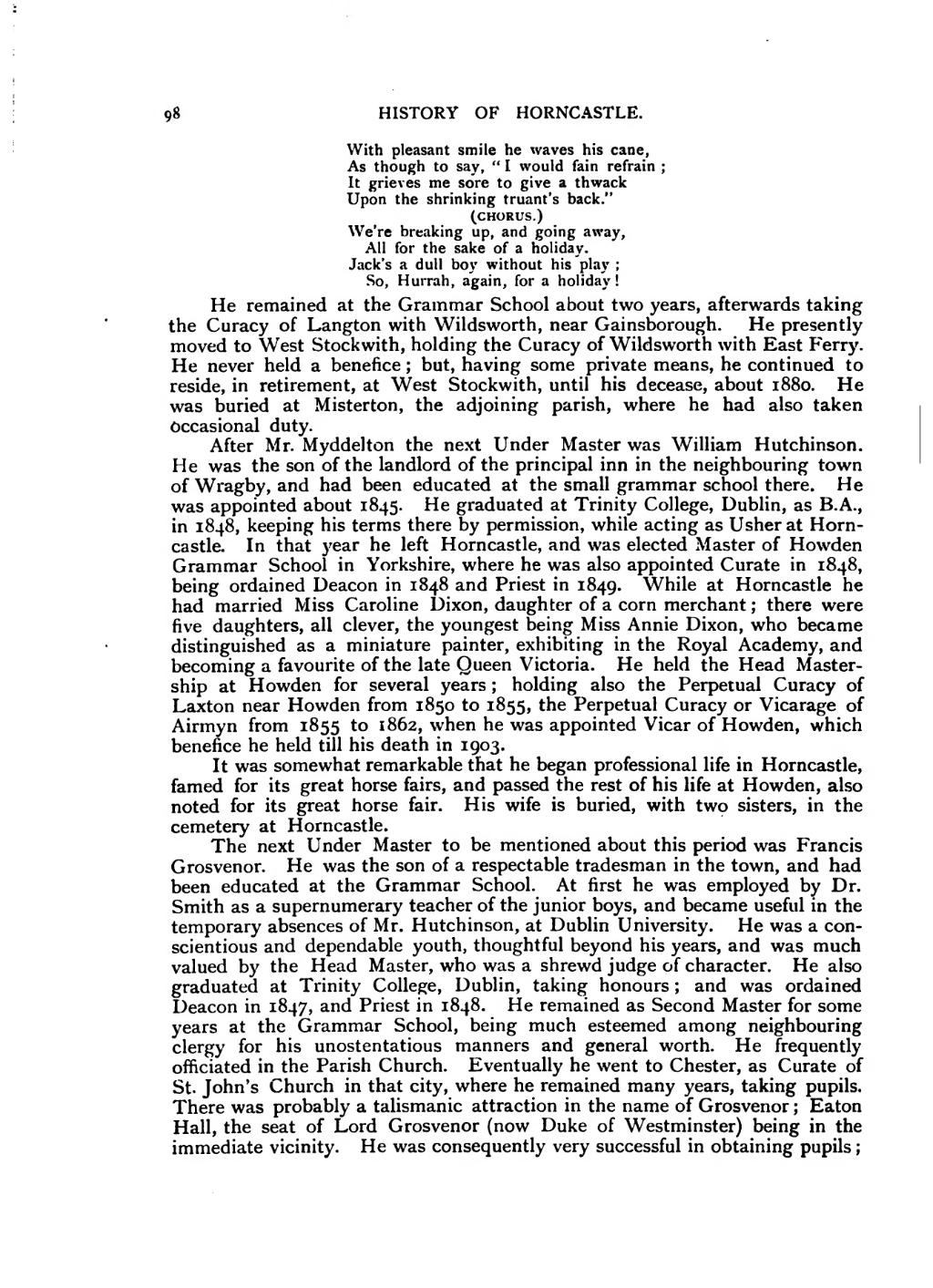With pleasant smile he waves his cane,
As though to say, "I would fain refrain;
It grieves me sore to give a thwack
Upon the shrinking truant's back."
(CHORUS.)
We're breaking up, and going away,
All for the sake of a holiday.
Jack's a dull boy without his play;
So, Hurrah, again, for a holiday!
He remained at the Grammar School about two years, afterwards taking the Curacy of Langton with Wildsworth, near Gainsborough. He presently moved to West Stockwith, holding the Curacy of Wildsworth with East Ferry. He never held a benefice; but, having some private means, he continued to reside, in retirement, at West Stockwith, until his decease, about 1880. He was buried at Misterton, the adjoining parish, where he had also taken occasional duty.
After Mr. Myddelton the next Under Master was William Hutchinson. He was the son of the landlord of the principal inn in the neighbouring town of Wragby, and had been educated at the small grammar school there. He was appointed about 1845. He graduated at Trinity College, Dublin, as B.A., in 1848, keeping his terms there by permission, while acting as Usher at Horncastle. In that year he left Horncastle, and was elected Master of Howden Grammar School in Yorkshire, where he was also appointed Curate in 1848, being ordained Deacon in 1848 and Priest in 1849. While at Horncastle he had married Miss Caroline Dixon, daughter of a corn merchant; there were five daughters, all clever, the youngest being Miss Annie Dixon, who became distinguished as a miniature painter, exhibiting in the Royal Academy, and becoming a favourite of the late Queen Victoria. He held the Head Mastership at Howden for several years; holding also the Perpetual Curacy of Laxton near Howden from 1850 to 1855, the Perpetual Curacy or Vicarage of Airmyn from 1855 to 1862, when he was appointed Vicar of Howden, which benefice he held till his death in 1903.
It was somewhat remarkable that he began professional life in Horncastle, famed for its great horse fairs, and passed the rest of his life at Howden, also noted for its great horse fair. His wife is buried, with two sisters, in the cemetery at Horncastle.
The next Under Master to be mentioned about this period was Francis Grosvenor. He was the son of a respectable tradesman in the town, and had been educated at the Grammar School. At first he was employed by Dr. Smith as a supernumerary teacher of the junior boys, and became useful in the temporary absences of Mr. Hutchinson, at Dublin University. He was a conscientious and dependable youth, thoughtful beyond his years, and was much valued by the Head Master, who was a shrewd judge of character. He also graduated at Trinity College, Dublin, taking honours; and was ordained Deacon in 1847, and Priest in 1848. He remained as Second Master for some years at the Grammar School, being much esteemed among neighbouring clergy for his unostentatious manners and general worth. He frequently officiated in the Parish Church. Eventually he went to Chester, as Curate of St. John's Church in that city, where he remained many years, taking pupils. There was probably a talismanic attraction in the name of Grosvenor; Eaton Hall, the seat of Lord Grosvenor (now Duke of Westminster) being in the immediate vicinity. He was consequently very successful in obtaining pupils;
